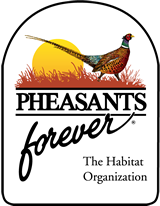Early September the PF Seed Program, helped sponsor a project to restore riparian and wet meadow habitat near the town of Craig in northwestern Colorado. Pheasants Forever Working Lands for Wildlife Biologists from Colorado, Wyoming, and Utah all participated in the event organized by the USFWS Partners for Fish and Wildlife Program, Colorado Parks and Wildlife, NRCS/PF-Working Lands for Wildlife, Bio-Logic, Wildland Restoration Volunteers (WRV), and Visintainer Sheep Co, where the project took place.
Wet meadows, or mesic areas, contain crucial brood-rearing habitat for the Greater Sage Grouse and host numerous benefits to other wildlife and livestock. In these sagebrush rangelands of northwestern Colorado elk and mule deer along with neo-tropical migratory birds use these wet meadows at some point throughout the year. Over time the meadows have been damaged by erosion and lower water tables altered by drought, intense rain events, and a changing climate.
Using simple but innovative techniques derived from restoration guru Bill Zeedyk the group was able to start restoring the meadow with rock, or “Zeedyk” structures. The goal with these structures is to raise the water table, slow erosion, and support a diversity of plants and insects. These wet meadows are crucial to the Greater Sage Grouse as within the first few weeks of being hatched chicks need high protein insects to survive into adolescence and these mesic areas provide this excellent habitat. The wet meadows also allow plants to stay green, and grow later in the season, providing excellent forage for elk, deer, and livestock. Since soil disturbance is an integral facet of the rock structure implementation the PF Seed Program was able to provide a native pollinator forb seed mix in and around these structures to promote greater insect pollinator activity, providing excellent early brood rearing habitat for Greater Sage Grouse. The South Denver Metro Pheasants Forever Chapter of Colorado donated the seed and PF Chapters in CO help contribute to our private land’s biologist program ensuring that projects like these continue to grow.
Dozens of volunteers were mentored and led by Bob Timberman of USFWS Partners for Fish and Wildlife Program, Shawn Conner of Bio-Logic, Brian Holmes of CO Parks & Wildlife, William Vieth of Wildlands Restoration Volunteers, and Rebecca Burton a Working Lands for Wildlife Biologist with Pheasants Forever/NRCS. Wildlands Restoration Volunteers, a Colorado based non-profit who organizes volunteers to work on conservation projects in Colorado and southern Wyoming, was an integral component of the project as they organized and provided the manpower to make quite an impact. The Covid-19 pandemic brought additional challenges implementing the project, but by limiting the group size to 25 volunteers per day, maintaining social distancing of 6+ feet whenever possible, and wearing masks while working in close proximities allowed to make it a reality.
Throughout the 4-day event almost 50 structures were built, new partnerships developed, and numerous encounters with the Greater Sage Grouse to the point where a few were able to harvest this iconic bird on surrounding public lands. Special thanks goes out to all the partners involved while Pheasants Forever looks forward to other opportunities of wet meadow restoration in the West.

















